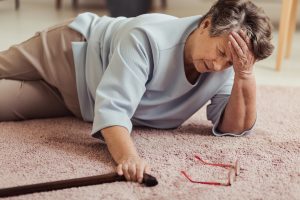
Be aware of the risks and take steps to preemptively reduce injury due to falls for seniors with osteoporosis.
According to the National Council of Aging (NCOA), about 54 million people in the United States are living with osteoporosis, a degenerative condition that weakens the bones, heightening the risk for breaks and fractures. Even further, the NCOA reports that one out of every five falls amongst older adults result in a serious injury, such as a broken bone, which can be detrimental to an aging adult.
Seniors with osteoporosis live with a particularly higher risk for these falls, as well as the injuries that can follow, as osteoporosis can contribute to body aches, loss of balance, and altered posture. However, there are steps you can take to help avoid the risk of falls for seniors with osteoporosis. First, let’s identify if the aging adult you care for is at risk.
Who is at risk for osteoporosis?
According to the National Institute of Arthritis and Musculoskeletal and Skin Diseases (NIAMS), the following factors can create a higher risk of osteoporosis:
- Age – The older we get, the faster our bones deteriorate, and the slower they experience growth, which is a direct cause of osteoporosis.
- Sex – Women have a lower peak bone mass and are at a greater risk for osteoporosis, but men are still at risk, especially after the age of 70.
- Body size – Slender people with naturally thinner bones are at a particular risk for the condition.
- Family history – Researchers have found that if a parent suffered from osteoporosis, their aging adult children are also at a higher risk.
Why are falls a particular concern for seniors with osteoporosis?
Osteoporosis essentially means “porous bone.” This means that the low bone mass in people with osteoporosis creates weaker, more brittle and fragile bones. However, our bones naturally get weaker over time, and osteoporosis is often referred to as a “silent disease” because it can go undetected until a break or fracture causes an aging adult to get tested for the disease.
The issue is that, sometimes, if a senior experiences a fall with undetected osteoporosis, it can be detrimental. The Bone Health and Osteoporosis Foundation explains that falls in older adults are not only more likely to result in broken bones, but the broken bones are likely to be major bones in the body, such as the hip, spine, or wrist. After breaking such vital bones, it’s not always as simple as waiting for the break to heal. Major bone breaks can result in a permanent loss of mobility, chronic pain, or a stooped or hunched posture.
Even further, the aftereffects of a break can be life-altering for aging adults. A loss of mobility can lead to depression in older adults. Chronic pain can also cause irritability and a loss of interest in daily activities. On top of these effects, healing from a broken bone can be an extremely costly process, creating a financial burden on the aging adult and their family.
With all of these concerns, it’s vital that seniors with osteoporosis have all the help necessary to limit the risks of falls.
How can I help prevent falls for seniors with osteoporosis?
The Osteoporosis Foundation offers the following tips to help avoid falls for seniors with osteoporosis:
- Practice a regular exercise routine, with a special focus on balance, to help build aging adults’ strength as they age and their muscles naturally begin to weaken.
- To avoid vision obstructions, make sure the aging adult’s glasses are clean, repaired, and that the prescription is up to date. It’s also important to pay attention to any glares the glasses could cause on particularly bright days.
- Ensure the aging adult is wearing sensible, comfortable shoes with adequate support.
- Fall-proof the home, which could mean removing loose rugs, installing handrails in the bathroom, and even upgrading the lighting around the home.
It’s also important to educate yourself on the risks associated with the medications an aging adult takes on a regular basis, as these can contribute to osteoporosis as well as changes in balance that can lead to a fall.
Making these changes could help avoid severe injury as osteoporosis progresses in aging adults. As a caregiver, it can also be helpful to consider any previous falls or stumbles the seniors has experienced and the factors that may have contributed to them.
If you or a loved one may benefit from in-home senior care in Hingham or any Massachusetts communities, My Personal Home Health Care offers both non-medical and skilled nursing care that can help! Our expert caregivers are prepared to help aging adults with osteoporosis stay safe and comfortable at home while maintaining their independence as they age. If you would like to hear more about our services, contact us online or call 508-386-3065 to start the conversation and schedule a free in-home consultation!

Recent Comments